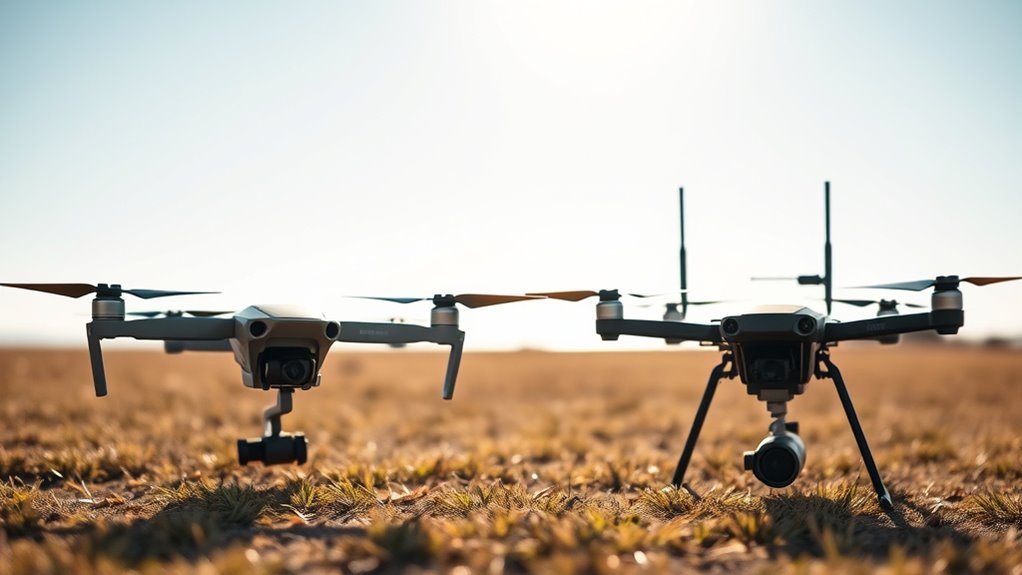You’ll find that the DJI Mini 3’s O3 technology delivers a 10 km radio range, outpacing the Freefly Astro Prime’s 5 km limit for your lightweight enterprise tasks. It’s ultra-light at under 250 grams with a foldable design, while the Astro Prime offers a rugged build for demanding environments. In real-world use, the Mini 3 excels in quick surveys, and the Astro Prime in tough inspections. Further details on these aspects await your review.
Radio Range and Performance Comparison
While both the DJI Mini 3 and Freefly Astro Prime deliver strong radio performance, their ranges differ considerably. You’ll find the DJI Mini 3’s O3 radio technology offers up to 10 km of reliable transmission, empowering you to explore vast areas with minimal restrictions. In contrast, the Freefly Astro Prime’s system tops out at around 5 km, which might limit your freedom in open environments.
When it comes to signal interference, the DJI Mini 3 employs advanced anti-interference algorithms in its radio technology, helping you maintain stable connections even in urban settings with Wi-Fi or other signals nearby. The Freefly Astro Prime, while robust, uses a more basic approach that can be susceptible to interference in crowded frequencies, potentially disrupting your flights. This means you’re choosing based on how much uninterrupted range you need for true aerial liberty, without compromising on technical reliability. Ultimately, both options enhance your control, but the DJI’s superior range gives you more room to roam freely. Additionally, advanced sensor technology featured in the DJI Air 3S provides an example of the high-quality systems that contribute to enhanced flight experiences.
Design Features and Build Quality
Beyond radio performance, you’ll notice the DJI Mini 3’s design emphasizes portability with its lightweight, foldable frame that weighs under 250 grams, making it easier to carry and comply with drone regulations. In contrast, the Freefly Astro Prime offers a more robust build for enterprise demands, featuring enhanced durability while maintaining a balance of weight and functionality. You’ll appreciate how the DJI Mini 3’s sleek lines provide superior aesthetic appeal, whereas the Astro Prime prioritizes ruggedness for real freedom in varied environments. Furthermore, Yuneec’s commitment to affordable, sustainable designs aligns with the evolving needs of both casual users and professionals in the drone market.
For a deeper durability assessment, here’s a comparison:
| Aspect | DJI Mini 3 | Freefly Astro Prime |
|---|---|---|
| Portability | Ultra-light, foldable | Moderately portable |
| Aesthetic Appeal | Sleek, modern design | Functional, industrial look |
| Durability Assessment | Good for casual use | High resistance to elements |
| Build Materials | Plastic composites | Reinforced alloys |
This setup lets you choose based on your need for effortless mobility or enduring reliability.
Real-World Applications for Enterprises
In enterprise environments, drones like the DJI Mini 3 and Freefly Astro Prime address specific needs, with the Mini 3’s lightweight design suiting tasks such as rapid site surveys or inventory checks, while the Astro Prime’s durable build supports demanding operations like infrastructure inspections or public safety missions.
You can leverage the DJI Mini 3 for aerial surveying in tight spaces, where its portability lets you quickly capture high-resolution data without setup delays, freeing you to focus on real-time decision-making. For infrastructure inspection, the Astro Prime’s robust frame and longer range enable you to tackle large-scale assessments, like bridge or pipeline evaluations, with enhanced stability in windy conditions. This gives you the freedom to operate autonomously, minimizing downtime and maximizing efficiency. In contrast, the Mini 3’s ease of deployment suits your needs for frequent, low-altitude aerial surveying tasks, ensuring precise mapping with minimal regulatory hurdles. Ultimately, both drones empower you to innovate in enterprise workflows, balancing speed and reliability for optimal outcomes. Furthermore, the integration of advanced sensors and algorithms will enhance the capabilities of these drones, enabling them to perform even better in variable conditions.
Frequently Asked Questions
What Is the Price of DJI Mini 3?
You’re enthusiastically uncovering the DJI Mini 3’s price, a key to your aerial freedom that might surprise you. It’s around $419 for the base model, offering excellent value in price comparisons against similar drones. Through value analysis, you’ll find its lightweight build and features deliver high performance at an affordable rate, letting you explore skies without hefty costs—empowering your adventures objectively.
How Long Does the Battery Last?
You’re wondering about battery performance and flight duration for your drone. The DJI Mini 3 typically offers up to 38 minutes of flight time under ideal conditions, showcasing strong battery efficiency. This extended duration gives you the freedom to capture more footage and explore wider areas without rushing. Factors like wind or temperature can reduce it, so monitor closely for peak, safe flights. Always prioritize safety.
What Accessories Are Included?
Imagine your drone as a bird ready to soar with the right wings—when you buy one, you’ll find basic accessories like propellers, a controller, and a carrying case included. For accessory compatibility, check if your model supports various third-party options, ensuring seamless integration. Don’t forget additional mounts for cameras or lights, giving you the freedom to customize and explore without limits. Always verify specifics for ideal performance.
Is There a Mobile App for Control?
You’re asking if there’s a mobile app for control, and yes, most systems include one that enhances mobile features like real-time monitoring and flight adjustments. You’ll find strong app compatibility with iOS and Android devices, allowing seamless integration. This setup gives you the freedom to manage operations intuitively, without being tethered, ensuring objective, technical control wherever you go. It’s designed for easy, autonomous use.
What Is the Warranty Period?
When you’re exploring warranty details for drones, you’ll find that standard coverage options typically include a 1-year period for manufacturer defects, covering parts and labor. Extended plans might offer up to two years or additional protections like accidental damage. This flexibility lets you choose what’s best for your adventures, ensuring reliable safeguards without tying you down to rigid commitments. Always verify specifics with the seller.

